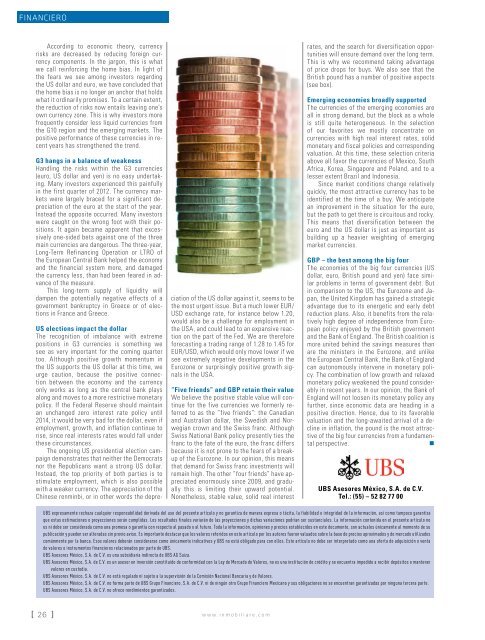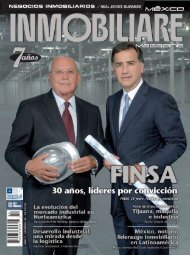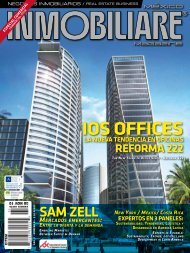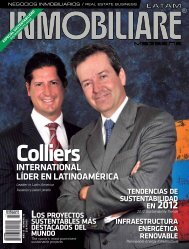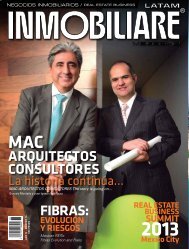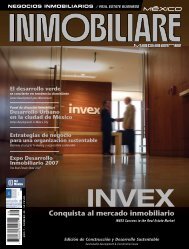INMOBILIARE No. 71
INMOBILIARE No. 71
INMOBILIARE No. 71
- No tags were found...
You also want an ePaper? Increase the reach of your titles
YUMPU automatically turns print PDFs into web optimized ePapers that Google loves.
financieroAccording to economic theory, currencyrisks are decreased by reducing foreign currencycomponents. In the jargon, this is whatwe call reinforcing the home bias. In light ofthe fears we see among investors regardingthe US dollar and euro, we have concluded thatthe home bias is no longer an anchor that holdswhat it ordinarily promises. To a certain extent,the reduction of risks now entails leaving one’sown currency zone. This is why investors morefrequently consider less liquid currencies fromthe G10 region and the emerging markets. Thepositive performance of these currencies in recentyears has strengthened the trend.G3 hangs in a balance of weaknessHandling the risks within the G3 currencies(euro, US dollar and yen) is no easy undertaking.Many investors experienced this painfullyin the first quarter of 2012. The currency marketswere largely braced for a significant depreciationof the euro at the start of the year.Instead the opposite occurred. Many investorswere caught on the wrong foot with their positions.It again became apparent that excessivelyone-sided bets against one of the threemain currencies are dangerous. The three-year,Long-Term Refinancing Operation or LTRO ofthe European Central Bank helped the economyand the financial system more, and damagedthe currency less, than had been feared in advanceof the measure.This long-term supply of liquidity willdampen the potentially negative effects of agovernment bankruptcy in Greece or of electionsin France and Greece.US elections impact the dollarThe recognition of imbalance with extremepositions in G3 currencies is something wesee as very important for the coming quartertoo. Although positive growth momentum inthe US supports the US dollar at this time, weurge caution, because the positive connectionbetween the economy and the currencyonly works as long as the central bank playsalong and moves to a more restrictive monetarypolicy. If the Federal Reserve should maintainan unchanged zero interest rate policy until2014, it would be very bad for the dollar, even ifemployment, growth, and inflation continue torise, since real interests rates would fall underthese circumstances.The ongoing US presidential election campaigndemonstrates that neither the Democratsnor the Republicans want a strong US dollar.Instead, the top priority of both parties is tostimulate employment, which is also possiblewith a weaker currency. The appreciation of theChinese renminbi, or in other words the depreciationof the US dollar against it, seems to bethe most urgent issue. But a much lower EUR/USD exchange rate, for instance below 1.20,would also be a challenge for employment inthe USA, and could lead to an expansive reactionon the part of the Fed. We are thereforeforecasting a trading range of 1.28 to 1.45 forEUR/USD, which would only move lower if wesee extremely negative developments in theEurozone or surprisingly positive growth signalsin the USA.“Five friends” and GBP retain their valueWe believe the positive stable value will continuefor the five currencies we formerly referredto as the “five friends”: the Canadianand Australian dollar, the Swedish and <strong>No</strong>rwegiancrown and the Swiss franc. AlthoughSwiss National Bank policy presently ties thefranc to the fate of the euro, the franc differsbecause it is not prone to the fears of a breakupof the Eurozone. In our opinion, this meansthat demand for Swiss franc investments willremain high. The other “four friends” have appreciatedenormously since 2009, and graduallythis is limiting their upward potential.<strong>No</strong>netheless, stable value, solid real interestrates, and the search for diversification opportunitieswill ensure demand over the long term.This is why we recommend taking advantageof price drops for buys. We also see that theBritish pound has a number of positive aspects(see box).Emerging economies broadly supportedThe currencies of the emerging economies areall in strong demand, but the block as a wholeis still quite heterogeneous. In the selectionof our favorites we mostly concentrate oncurrencies with high real interest rates, solidmonetary and fiscal policies and correspondingvaluation. At this time, these selection criteriaabove all favor the currencies of Mexico, SouthAfrica, Korea, Singapore and Poland, and to alesser extent Brazil and Indonesia.Since market conditions change relativelyquickly, the most attractive currency has to beidentified at the time of a buy. We anticipatean improvement in the situation for the euro,but the path to get there is circuitous and rocky.This means that diversification between theeuro and the US dollar is just as important asbuilding up a heavier weighting of emergingmarket currencies.GBP – the best among the big fourThe economies of the big four currencies (USdollar, euro, British pound and yen) face similarproblems in terms of government debt. Butin comparison to the US, the Eurozone and Japan,the United Kingdom has gained a strategicadvantage due to its energetic and early debtreduction plans. Also, it benefits from the relativelyhigh degree of independence from Europeanpolicy enjoyed by the British governmentand the Bank of England. The British coalition ismore united behind the savings measures thanare the ministers in the Eurozone, and unlikethe European Central Bank, the Bank of Englandcan autonomously intervene in monetary policy.The combination of low growth and relaxedmonetary policy weakened the pound considerablyin recent years. In our opinion, the Bank ofEngland will not loosen its monetary policy anyfurther, since economic data are heading in apositive direction. Hence, due to its favorablevaluation and the long-awaited arrival of a declinein inflation, the pound is the most attractiveof the big four currencies from a fundamentalperspective.•UBS Asesores México, S.A. de C.V.Tel.: (55) – 52 82 77 00UBS expresamente rechaza cualquier responsabilidad derivada del uso del presente artículo y no garantiza de manera expresa o tácita, la fiabilidad o integridad de la información, así como tampoco garantizaque estas estimaciones o proyecciones serán cumplidas. Los resultados finales variarán de las proyecciones y dichas variaciones podrían ser sustanciales. La información contenida en el presente artículo noes ni debe ser considerada como una promesa o garantía con respecto al pasado o al futuro. Toda la información, opiniones y precios establecidos en este documento, son actuales únicamente al momento de supublicación y pueden ser alteradas sin previo aviso. Es importante destacar que los valores referidos en este artículo por los autores fueron valuados sobre la base de precios aproximados y de mercado utilizadoscomúnmente por la banca. Esos valores deberán considerarse como únicamente indicativos y UBS no está obligado para con ellos. Este artículo no debe ser interpretado como una oferta de adquisición o ventade valores o instrumentos financieros relacionados por parte de UBS.UBS Asesores México, S.A. de C.V. es una subsidiaria indirecta de UBS AG Suiza.UBS Asesores México, S.A. de C.V. es un asesor en inversión constituido de conformidad con la Ley de Mercado de Valores, no es una institución de crédito y se encuentra impedido a recibir depósitos o mantenervalores en custodia.UBS Asesores México, S.A. de C.V. no está regulado ni sujeto a la supervisión de la Comisión Nacional Bancaria y de Valores.UBS Asesores México, S.A. de C.V. no forma parte de UBS Grupo Financiero, S.A. de C.V. ni de ningún otro Grupo Financiero Mexicano y sus obligaciones no se encuentran garantizadas por ninguna tercera parte.UBS Asesores México, S.A. de C.V. no ofrece rendimientos garantizados.26www.inmobiliare.com


